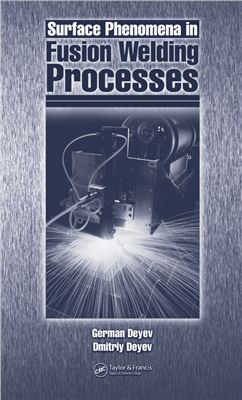CRC Press, Taylor & Francis Group, 2006, Pages: 407
The manufacturing industry currently employs a wide variety of welding processes. The main technological process applied in the production of weldments is fusion welding. Presenting the latest research on the topic, Surface Phenomena in Fusion Welding Processes is a cutting-edge and comprehensive book that details the various courses of action that occur during welding procedures. It explains established regularities that are useful in the development of processes; details the formation of defects, allowing for an understanding of the role of surface properties and surface phenomena during the formation of defects; and describes welding in space, elucidating the determination role of surface phenomena in that environment. The text also contains 217 figures, 29 tables, and 336 equations to provide the reader with a better understanding of the various processes. In the development of welding technologies, as well as welding consumables, it is essential to know and to take into account both the surface properties of the applied materials and the surface phenomena that affect the boundaries of contacting phases. Surface Phenomena in Fusion Welding Processes presents this knowledge in a thorough and accessible manner, making it the ideal reference for practical and scientific specialists in the fields of welding and metallurgy.
Characterization of the Fusion Welding Process
Surface Properties and Phenomena
Results of Studying the Surface Properties and Phenomena
Electrode-Metal Transfer and Surface Phenomena
Formation of Weld and Deposited Metal
Non-Metallic Inclusions
Porosity in Welds
Solidification Cracking
Development of Welding and Surfacing Technologies with Allowance for Surface Phenomena
The manufacturing industry currently employs a wide variety of welding processes. The main technological process applied in the production of weldments is fusion welding. Presenting the latest research on the topic, Surface Phenomena in Fusion Welding Processes is a cutting-edge and comprehensive book that details the various courses of action that occur during welding procedures. It explains established regularities that are useful in the development of processes; details the formation of defects, allowing for an understanding of the role of surface properties and surface phenomena during the formation of defects; and describes welding in space, elucidating the determination role of surface phenomena in that environment. The text also contains 217 figures, 29 tables, and 336 equations to provide the reader with a better understanding of the various processes. In the development of welding technologies, as well as welding consumables, it is essential to know and to take into account both the surface properties of the applied materials and the surface phenomena that affect the boundaries of contacting phases. Surface Phenomena in Fusion Welding Processes presents this knowledge in a thorough and accessible manner, making it the ideal reference for practical and scientific specialists in the fields of welding and metallurgy.
Characterization of the Fusion Welding Process
Surface Properties and Phenomena
Results of Studying the Surface Properties and Phenomena
Electrode-Metal Transfer and Surface Phenomena
Formation of Weld and Deposited Metal
Non-Metallic Inclusions
Porosity in Welds
Solidification Cracking
Development of Welding and Surfacing Technologies with Allowance for Surface Phenomena

